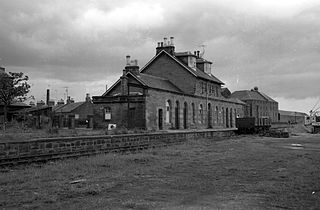Related Research Articles
The Edinburgh and Glasgow Railway was authorised by Act of Parliament on 4 July 1838. It was opened to passenger traffic on 21 February 1842, between its Glasgow Queen Street railway station and Haymarket railway station in Edinburgh. Construction cost £1,200,000 for 46 miles (74 km). The intermediate stations were at Corstorphine, Gogar, Ratho, Winchburgh, Linlithgow, Polmont, Falkirk, Castlecary, Croy, Kirkintilloch and Bishopbriggs. There was a ticket platform at Cowlairs. The line was extended eastwards from Haymarket to North Bridge in 1846, and a joint station for connection with the North British Railway was opened on what is now Edinburgh Waverley railway station in 1847.

Larbert railway station is a railway station serving Larbert near Falkirk, Scotland.
The Denbigh, Ruthin and Corwen Railway was a standard gauge railway line that connected Corwen with Denbigh via Ruthin in North Wales.
The Scottish Central Railway was formed in 1845 to link Perth and Stirling to Central Scotland, by building a railway line to join the Edinburgh and Glasgow Railway near Castlecary.

Alloa railway station is a railway station in the town of Alloa, Clackmannanshire, Scotland, which was re-opened on Monday, 19 May 2008.

The Stirling and Dunfermline Railway was a railway in Scotland connecting Stirling and Dunfermline. It was planned by the Edinburgh and Glasgow Railway to get access to the mineral deposits on the line of route, but also as a tactical measure to keep the rival Caledonian Railway out of Fife.
The Kincardine Line is a railway in Clackmannanshire and Fife, Scotland. It was originally built to serve settlements along the north shore of the Firth of Forth, between Alloa and Dunfermline.
The Alloa Railway was intended to bridge the River Forth linking Alloa with the south without using a ferry.
The Forth and Clyde Junction Railway was a railway line in Scotland which ran from Stirling to Balloch.
The Strathspey Railway was a railway company in Scotland that ran from Dufftown to Boat of Garten. It was proposed locally but supported by the larger Great North of Scotland Railway (GNoSR), which wanted to use it as an outlet towards Perth. The GNoSR had to provide much of the funding, and the value of traffic proved to be illusory. The line opened in 1863 to Abernethy, but for the time being was unable to make the desired connection to the southward main line. Although later some through goods traffic developed, the route never achieved its intended purpose.
The Edinburgh and Northern Railway was a railway company authorised in 1845 to connect Edinburgh to both Perth and Dundee. It relied on ferry crossings of the Firth of Forth and the Firth of Tay, but despite those disadvantages it proved extremely successful. It took over a short railway on the southern shore of the Forth giving a direct connection to Edinburgh, and it changed its name to the Edinburgh, Perth and Dundee Railway.

Thongs Bridge railway station was the only intermediate stop on the railway line between Brockholes and Holmfirth, West Yorkshire, England. Opened in July 1850, the station was temporarily closed in 1865 due to the collapse of Mytholmbridge Viaduct. The station closed to passengers permanently in 1959, closing completely in 1965.
Airth was a railway station serving Airth in the Scottish county of Falkirk.

Thorpe on the Hill railway station was a station serving the village of Thorpe-on-the-Hill, Lincolnshire, England.
Bonnybridge railway station was a railway station serving the village of Bonnybridge in central Scotland. The station was located on a short branch off the Caledonian Railway line from Coatbridge to Larbert.

The Montrose and Bervie Railway was a Scottish railway. When the Aberdeen Railway opened in 1850, the coastal settlements north of Montrose were not linked in, and local interests promoted a branch line from Montrose to Bervie. They found it impossible to raise capital at first, but from 1861 the larger railways were promoting new connections around Aberdeen, and the Great North of Scotland Railway (GNoSR) decided that the Bervie line would give it a route to the south.

Lowton railway station served the village named Town of Lowton to the east of Newton-le-Willows and south of Golborne.
The Railways of Kinross were a local network of three rural railways which made the town of Kinross in Scotland their objective in the 1850s.
South Alloa railway station, located south of the River Forth, served the village of South Alloa, Scotland and the town of Alloa via a ferry link from 1850 to 1885.
Gascoigne Wood Junction railway station was a railway station near Sherburn-in-Elmet in North Yorkshire, England. It was originally opened as a junction station, enabling transfers for passengers between trains. It was later a private halt station for the staff who worked at the Gascoigne Wood marshalling yard. It opened in 1839, and was closed, renamed and re-opened several times before closing completely in 1959. The station was 14 miles (23 km) from Leeds New Station, and 6 miles (9.7 km) from Selby.
References
- 1 2 Quick, Michael (2022) [2001]. Railway passenger stations in Great Britain: a chronology (PDF). version 5.04. Railway & Canal Historical Society. p. 49. Archived from the original (PDF) on 25 November 2022.
- ↑ "Alloa Junction on 25 inch map Stirlingshire XXIV.2 (St. Ninians)". National Library of Scotland. 1862. Retrieved 28 July 2020.
- ↑ "Grand Cheap Pleasure Excursion" . Stirling Observer. 12 June 1851. p. 1. Retrieved 28 July 2020– via British Newspaper Archive.
- ↑ Bradshaw, George (1855). Bradshaw's General Railway and Steam Navigation Guide, for Great Britain and Ireland. Manchester: Bradshaw & Blacklock.
- ↑ Hurst, Geoffrey (1992). Register of Closed Railways: 1948-1991. Worksop, Nottinghamshire: Milepost Publications. pp. 5 & 70 (refs 0151 & 3083). ISBN 0-9477-9618-5.